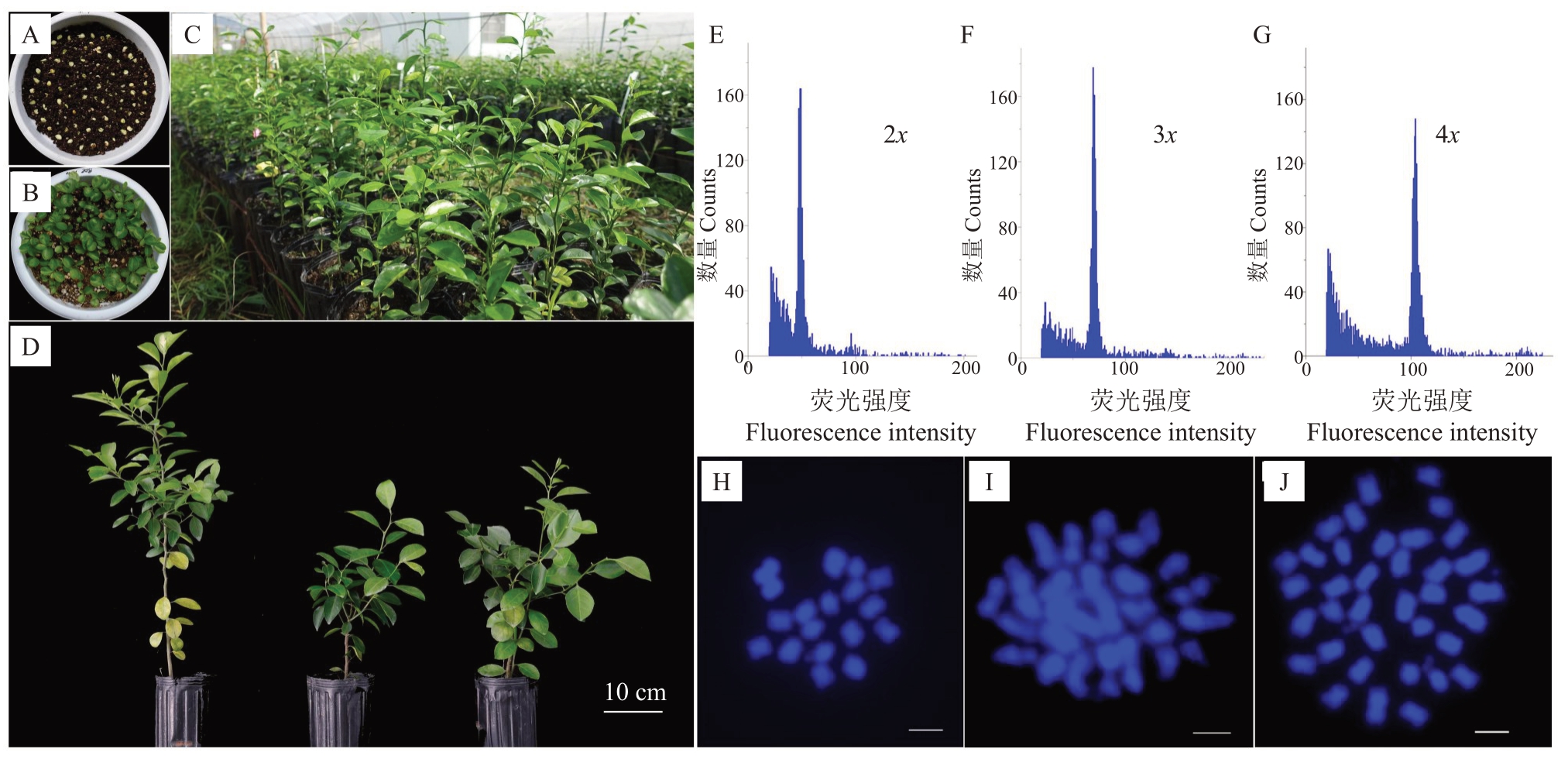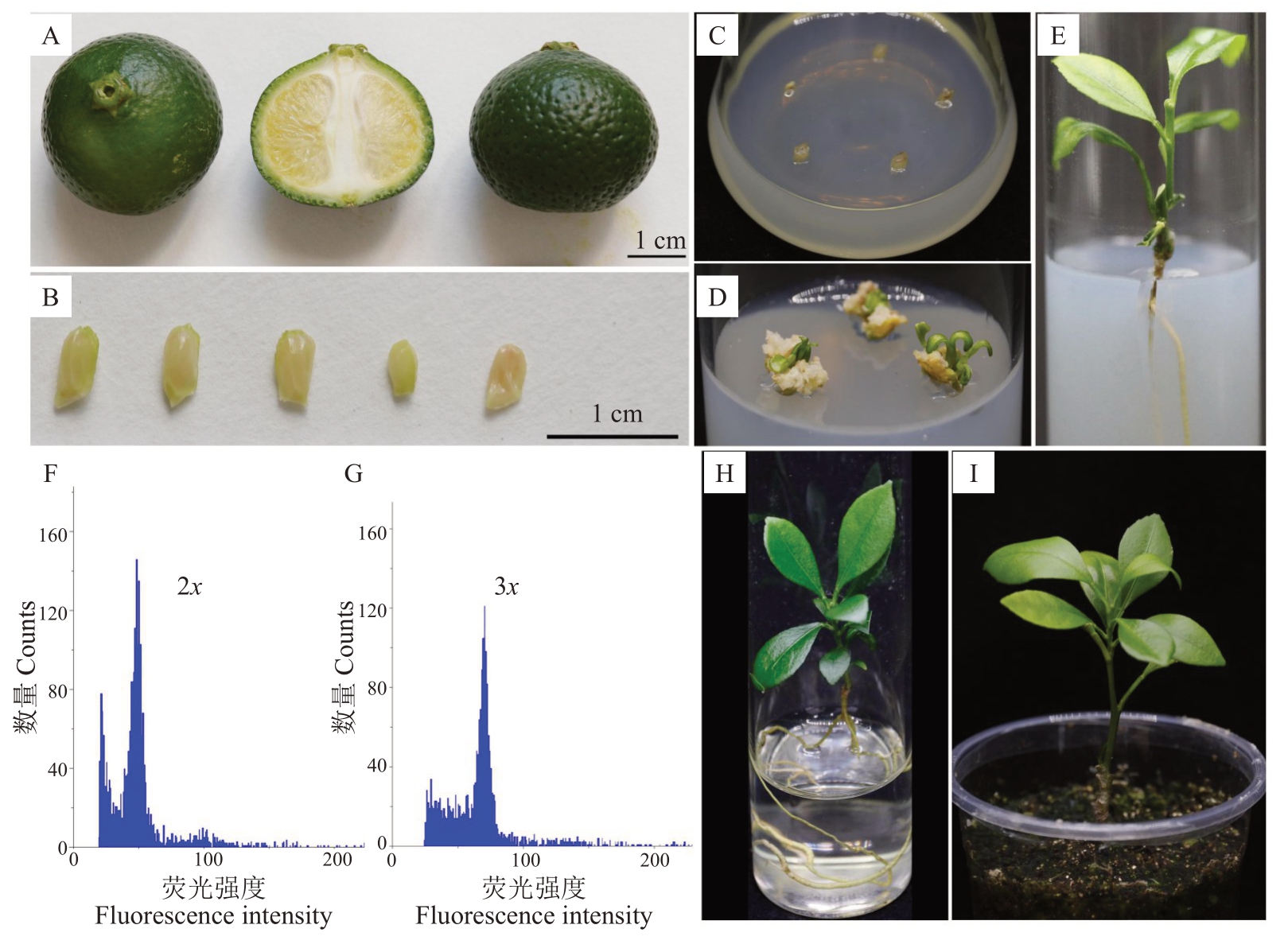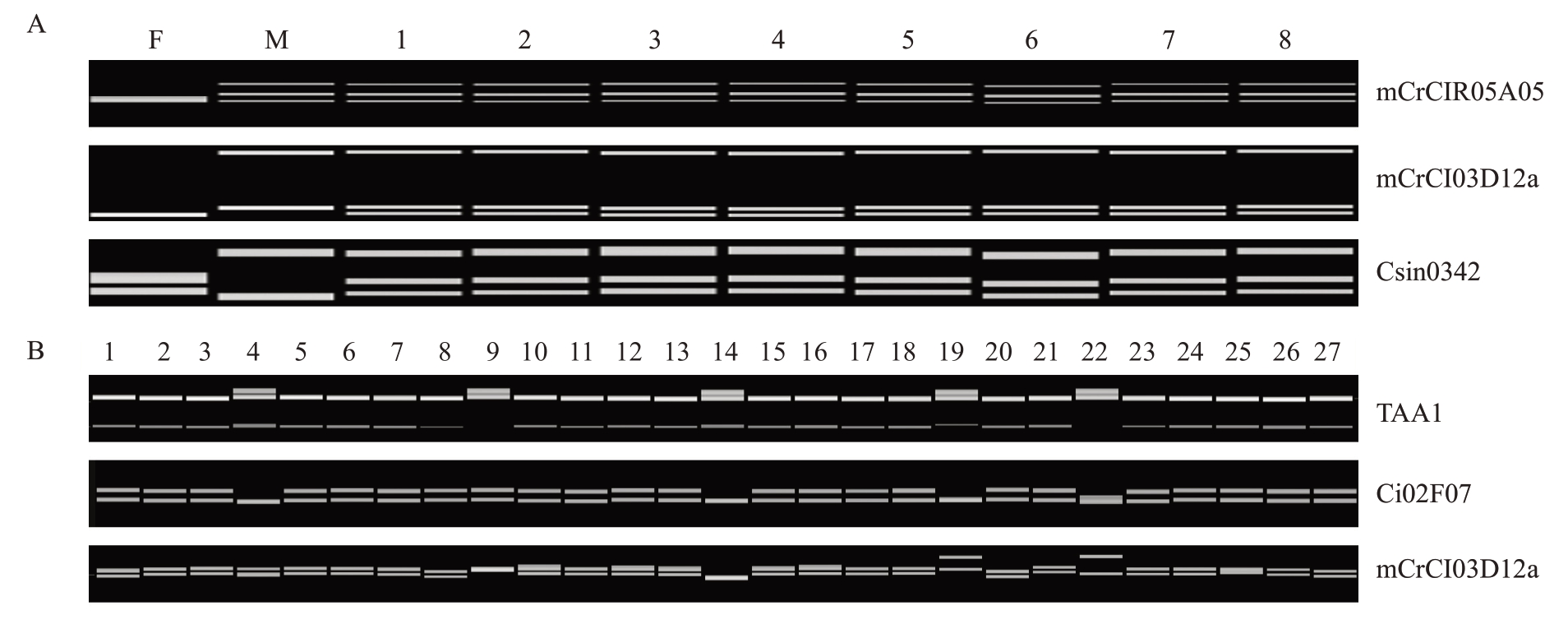本地早橘(Citrus succosa Hort. ex Tanaka),原产浙江黄岩,是“黄岩蜜橘”区域品牌的代表品种,味甜酸少,有香气,是鲜食和制罐兼优品种[1]。20世纪80 年代,本地早橘在黄岩地区进入发展鼎盛时期,当前柑橘园中的橘树多为当时所种。然而,长期无性繁殖导致本地早橘种性衰退,产量与品质明显下降;同时由于本地早橘果实有核[2]和近几十年国外无核宽皮柑橘的大量引进,本地早橘生产受到市场冲击,导致其在黄岩乃至浙江地区种植面积和产量锐减,甚至面临市场淘汰的困境,“黄岩蜜橘”品牌效益也受到很大冲击。因此,对本地早橘进行品质提升,创制具有应用潜力的无核新种质,是解决黄岩本地早橘果实有核和品质退化等产业问题和提升“黄岩蜜橘”品牌价值的有效策略。
二倍体与四倍体倍性杂交创制三倍体是转移有益农艺性状和培育无核柑橘新品种的有效途径,对丰富柑橘资源和进行无核品种改良具有重要意义[3]。特别是以异源四倍体为亲本与二倍体倍性杂交创制的三倍体有望在无核的基础上,实现3 个亲本优良性状聚合,遗传变异将更加丰富,更易培育出果实无核且性状优良的柑橘新品种[4]。华中农业大学前期通过细胞融合技术创制了大批柑橘异源四倍体,并以其为父本与中国一些地方特色有核品种为母本进行倍性杂交,创制获得了3500余株三倍体后代[5-6]。但利用细胞融合技术创制异源四倍体技术难度较高,与之相比,基于多胚品种珠心细胞易自然加倍的特点[7]发掘双二倍体(同源四倍体)相对容易,且以双二倍体为亲本与其对应二倍体有性杂交创制同源三倍体,有望在不改变原有品种其他性状条件下,实现果实无核,更具应用价值。若能发掘本地早橘双二倍体资源,通过开展本地早橘二倍体与其双二倍体间的倍性杂交创制同源三倍体,有望在维持原有品种性状的基础上,培育获得果实无核的本地早橘新品种。基于此,笔者在本研究中拟以本地早橘为材料,通过实生播种、倍性杂交等手段,发掘和创制本地早四倍体和三倍体新种质,为本地早橘无核化品种选育及“黄岩蜜橘”品牌振兴提供核心种质资源。
1 材料和方法
1.1 试验材料
以本地早橘(Citrus succosa Hort. ex Tanaka)为材料开展四倍体资源发掘和倍性杂交创制三倍体工作。用于实生播种的本地早橘成熟种子采自浙江黄岩蜜橘种源研究中心自然授粉的果实。以本地早橘为母本,异源四倍体BDZNS[本地早橘(C. succosa Hort.ex Tanaka)与异源四倍体体细胞杂种NS(C.reticulata×C.paradise+C.sinensis)倍性杂交获得[8]]为父本进行倍性杂交,授粉地点为黄岩蜜橘种源研究中心,异源四倍体BDZNS的花粉采自华中农业大学柑橘种质资源圃。
1.2 种子催芽及实生播种
本地早橘种子实生播种及多倍体发掘参考周锐等[9]的方法。将种子从果实中剥出后,用1 mol·L-1 NaOH溶液消毒后去掉外种皮,并置于28 ℃暗培养箱中催芽2~3 d,胚根露白后将其播种于营养钵,待幼苗长至2~3 枚真叶时,利用“观根辨叶看油胞”发掘多倍体的技术,筛选疑似四倍体植株并用流式细胞仪对其进行倍性鉴定。
1.3 花粉制备与人工授粉
四倍体花粉制备参考解凯东等[2]的方法,花粉制备好后暂置于4 ℃冰箱保存备用。本地早橘盛花期前期,选择晴朗无风的天气进行授粉,优先选择生长健壮且花量大的枝条,授粉时去除枝条上已经开放的花和小花蕾,选择即将开放的花蕾进行人工去雄后授粉,授粉后套袋避免其他品种花粉干扰[6]。授粉后1 周进行保果处理(喷施3%赤霉酸2000 倍液+0.01%芸薹素内酯3000 倍液+KH2PO4 1000 倍液)。
1.4 幼胚离体挽救培养
于授粉后90 d,采集授粉后的幼果用于幼胚离体挽救培养,具体参考Xie 等[10]的方法。无菌条件下,用75%乙醇浸泡授粉的幼果15 min 后置于酒精灯上燃烧消毒;消毒完毕后剥取幼嫩胚珠并离体培养;幼胚萌发后,分别将其继代至生芽培养基增殖生芽,长出2~3枚真叶后,将萌发的茎段切下转移至生根培养基诱导生根。待植株生根后,用流式细胞仪对再生植株进行倍性鉴定筛选多倍体;最后对筛选出的多倍体幼苗进行炼苗并移栽至温室保存。
1.5 植株倍性鉴定
用流式细胞仪(Cyflow space,Sysmex,Japan)对实生发掘的疑似多倍体和幼胚离体挽救培养再生植株进行倍性分析,详细过程参照解凯东等[2]的方法,待测样品的倍性分析图由流式细胞仪自带的Flo-Max 软件自动生成。根尖染色体计数参照谢善鹏等[7]的方法,将1 mm 初生根尖在20 ℃饱和对二氯苯溶液中水浴3 h后,在0.075 mol·L-1 KCl溶液中室温处理30 min,用新制卡诺固定液(乙醇∶乙酸=3∶1,体积比)常温固定24 h,置于70%乙醇溶液4 ℃保存备用。用2%纤维素酶+ 20%果胶酶(1∶1)酶液37 ℃水浴90 min酶解根尖后制片观察。
1.6 SSR分子标记鉴定
基因组DNA 提取参考Cheng 等[11]的方法。用基于毛细管电泳(QIAxcel Advanced,Germany)的SSR分子标记对实生发掘的四倍体和倍性杂交创制的三倍体进行遗传鉴定,详细方法参考谢善鹏等[7]的报道。SSR 引物筛选标准:用于实生发掘四倍体后代遗传鉴定的SSR引物需在本地早橘中能扩增出2 条带;用于倍性杂交后代遗传鉴定的SSR 引物需满足父母间具有多态性且父本要有特异条带。依据该标准,从前人发表的SSR引物[12-15]中筛选获得5对多态性SSR引物(表1)对获得的多倍体材料进行遗传鉴定,所有引物由上海生物工程股份有限公司合成。
表1 SSR 引物序列
Table 1 Sequence of SSR primers

引物名称Primer name mCrCIR05A05 mCrCI03D12a Csin0342 TAA1 Ci02F07正向序列Forward sequence ATACCTGTGAGCGTGAG GCCATAAGCCCTTTCT GTGCCCATGTCTGATTTCAA GACAACATCAACAACAGCAAGAGC GCAGCGTTTGTTTTCT反向序列Reverse sequence CCTCTTCCCTTCCATT CCCACAACCATCACC TCACCCATAGTCCCGGTAAC AAGAAGAAGAGCCCCCATTAGC TGCTGGTTTTCAGATACTT来源Reference[12][12][13][14][15]
2 结果与分析
2.1 基于实生播种和形态初选发掘本地早橘四倍体23株
果实成熟期,采集本地早橘果实1500 个,剥取获得成熟种子7500余粒,催芽播种后获得实生幼苗9000 余株(图1-A~B)。将其移入温室后(图1-C),根据多倍体具有植株矮化、叶片颜色变深和叶形指数变小等形态特点,从9000余株实生幼苗中筛选获得51株疑似多倍体,利用流式细胞仪和根尖染色体计数对其倍性进行检测,获得23株四倍体和1株三倍体植株(图1-D~J),多倍体形态初筛准确率为47.06%,本地早橘多倍体自然发生率约0.27%。

图1 本地早橘四倍体实生发掘流程
Fig.1 The procedure of exploring tetraploid plants from the diploid seedlings of Bendizao tangerine
A.本地早橘种子催芽播种;B.本地早橘实生幼苗;C.实生幼苗移入温室后生长情况;D.不同倍性本地早橘植株株形对比(左:2x,中:3x,右:4x);E~G.用流式细胞仪对疑似多倍体进行倍性鉴定(E:二倍体,荧光强度约为50;F:三倍体,荧光强度约为75;G:四倍体,荧光强度约为100);H~J.根尖染色体计数(H:二倍体,2n=2x=18;I:三倍体,2n=3x=27;J:四倍体,2n=4x=36),标尺=2 μm。
A.Seed sowing in plastic pots;B.Young Seedlings of Bendizao tangerine;C.Large Seedlings that are growing in the greenhouse;D.Morphological comparison of the diploid seedlings(left)of Beidizao tangerine with their triploid(middle)and tetraploid(right)hybrid seedlings;E-G.Ploidy determination of the suspected polyploid plants by flow cytometry (E:Diploid, Fluorescence intensity ≈50; F:Triploid, Fluorescence intensity ≈75;G:Tetraploid,Fluorescence intensity ≈100);H-J.Shoot tip chromosome counting(H:Diploid,2n=2x=18;I:Triploid,2n=3x=27;J:Tetraploid,2n=4x=36),bar=2 μm.
2.2 以本地早橘为母本倍性杂交创制三倍体8株
以本地早为母本、异源四倍体BDZNS 为父本进行倍性杂交,授粉155 朵花,坐果35 个,坐果率22.58%;于授粉后90 d采集所有授粉果实(图2-A),无菌条件下从中剥取幼嫩胚珠105粒(图2-B),平均单果种子数3 粒;对所有幼嫩胚珠进行幼胚离体培养(图2-C~D)后获得再生植株78 株(图2-E);用流式细胞仪对所有再生植株进行倍性检测,从78株再生植株中筛选获得三倍体8株(图2-F~G),多倍体发生率10.26%;其中5株三倍体可以直接生根,通过炼苗移栽(图2-H)将其移入温室;剩余3 株难以生根,通过试管嫁接将其扩繁并移入温室(图2-I)。

图2 倍性杂交创制本地早橘三倍体的技术流程Fig.2 The procedure of producing triploid plants via interploidy cross in Bendizao tangerine
A.授粉后90 d 的本地早幼果;B.杂交获得的幼嫩胚珠;C.幼嫩胚珠离体接种于萌发培养基;D.幼嫩胚珠萌发形成胚状体;E.离体培养诱导生根的再生植株;F~G.再生植株的倍性鉴定(F:二倍体,荧光强度约为50;G:三倍体,荧光强度约为75);H.三倍体炼苗;I.三倍体嫁接后移栽。
A.Young fruits of Bendizao tangerine collected at 90 days after pollination;B.Immature seeds extracted from the pollinated young fruits of Bendizao tangerine; C. Immature seeds in vitro cultured in germinating medium; D. Embryoid formation after seed germination; E. The shoots getting roots after cultured in Root induction medium;F-G.Ploidy determination of the regenerated plants by flow cytometry(F:Diploid,Fluorescence intensity ≈50; G:Triploid, Fluorescence intensity ≈75); H.Triploid seedlings acclimation before being transferred into greenhouse; I.A grafted triploid plant transferred into the plastic pot.
2.3 基于SSR 分子标记的本地早橘三倍体和四倍体新种质遗传鉴定
筛选获得的5 对多态性SSR 引物中,3 对mCrCIR05A05、mCrCI03D12a、Csin0342 用于倍性杂交获得的三倍体遗传分析(图3-A),3 对mCrCI03D12a、TAA1、Ci02F07用于实生发掘获得的多倍体遗传分析(图3-B)。由图3可知,倍性杂交获得的8 株三倍体在3 个SSR 位点处均含有父本特异条带,表明其均为双亲的有性后代。而本地早橘实生播种获得23株四倍体后代中,19株四倍体后代在3 个SSR 位点处的带型与本地早橘完全一致,推测这些四倍体为本地早橘珠心细胞自然加倍形成;而其余4 个四倍体后代和1 株三倍体后代至少在2 个SSR 位点处的带型与本地早橘不一致,均含有异源条带(图3-B,第9、14、19、22号单株),推测其为本地早橘与周边其他品种天然有性杂交形成。

图3 本地早橘倍性杂交和实生发掘的多倍体后代的SSR 分子标记鉴定
Fig.3 Genetic origin analysis of the polyploid progenies obtained in this study using SSR molecular markers
A.本地早×BDZNS 倍性杂交创制的三倍体(F:本地早橘;M:异源四倍体BDZNS;1~8.三倍体后代);B.本地早橘实生发掘的多倍体(1~3:本地早橘二倍体实生苗;4:三倍体后代;5~27:四倍体后代)。
A. The SSR profile of the triploid progenies derived from the interploidy cross‘Bendizao tangerine × BDZNS’(F:The female parent Bendizao tangerine; M:The tetraploid male parent BDZNS; 1-8:The triploid progenies); B. The SSR profile of the tetraploid and triploid seedlings of Bendizao tangerine(1-3:The diploid nucellar seedlings of Bendizao tangerine;4:The triploid seedling;5-27:The tetraploid seedlings).
3 讨 论
针对黄岩地方特色品种本地早橘存在的果实有核、品质下降等问题,笔者在本研究中通过实生播种、倍性杂交结合幼胚离体挽救培养等技术,发掘或创制获得具有本地早橘血统的四倍体新种质24 株和三倍体新种质9 株,为本地早橘无核新品种培育和重振“黄岩蜜橘”品牌提供了宝贵的种质资源。
三倍体果实一般无核,在鲜食市场具有较高的消费需求,且三倍体果实一般较二倍体更大,营养更丰富[16],这些特点决定了三倍体在柑橘高品质鲜果市场具有较大的发展潜力,符合当前市场对鲜食柑橘的消费需求。前人通过分析不同三倍体有性群体果实糖酸含量,发现三倍体后代糖酸含量受四倍体父本影响较大[17-18],在本研究中,倍性杂交所用父本BDZNS 遗传物质1/2 来自本地早橘,以其为父本倍性杂交创制的三倍体后代能够在保证果实完全无核的基础上,较大限度地保留本地早橘原有性状,达到无核化与品质传承双重目标,进而实现本地早橘品种的提纯复壮。此外,三倍体对低温和干旱等非生物逆境胁迫[4]的耐受能力较强,利用倍性杂交策略创制的本地早橘三倍体资源可能在应对非生物胁迫方面表现优异。
柑橘四倍体植株与二倍体相比,通常表现植株矮、气孔密度小、初生代谢物积累多等特点。在本研究中,通过实生发掘获得的本地早橘四倍体植株株型较小、结构紧凑,利于密植栽培,未来有望能减少管理成本,为“黄岩蜜橘”的轻简化栽培提供了新方向。此外,本地早橘双二倍体还可作为核心种源进一步与其二倍体亲本进行倍性杂交,创制能最大限度保留本地早橘原有性状的同源三倍体无核新种质,形成“四倍体-三倍体”协同育种体系,为本地早橘品种品质提升和无核化改良奠定重要的种质基础。
通过对实生发掘获得的23株四倍体和1株三倍体进行多位点SSR遗传鉴定,发现19株四倍体在所有位点的带型与二倍体完全一致,推断其可能为本地早橘珠心细胞自然加倍形成的同源四倍体[4]。发掘获得的1 株三倍体在TAA1 位点由于存在异源特异条带,且在该位点扩增的3 条带中,2 条来自本地早橘,推断该三倍体为本地早橘产生的2n雌配子与外来n 雄配子受精产生,这也与目前柑橘中报道的天然三倍体多为2n 雌配子受精形成的结论相符[19-21]。此外,发现有4株四倍体的带型与本地早橘二倍体带型不一致,根据其SSR带型特点推断其可能有如下来源:1)本地早橘形成的2n雌配子与附近四倍体形成的二倍体雄配子受精形成。但用流式细胞仪对本地早橘母本树附近的柑橘植株进行了倍性分析,未发现四倍体植株,因此可排除该可能。2)本地早橘与周边二倍体有性杂交的合子胚再自然加倍形成。通过该途径形成的四倍体扩增条带应该不超过2 条,第9 和22 号四倍体单株在3 个SSR 位点处的条带数均不超过2条,因此推断这2株四倍体为本地早橘与其他二倍体品种有性杂交后再自然加倍形成。3)本地早橘形成的2n 雌配子与周边品种形成的2n 雄配子受精形成。减数分裂异常产生的2n 配子既可以纯合也可杂合,通过该途径产生的四倍体在不同位点的条带数一般介于1~4 条之间,根据第14和19号四倍体单株的SSR带型,推断其为本地早橘形成的2n 雌配子与其他二倍体品种产生的2n 雄配子受精形成。
4 结 论
笔者在本研究中针对黄岩本地早橘果实有核和品质下降等产业问题,利用实生播种发掘多倍体和倍性杂交创制三倍体的细胞工程育种技术,成功发掘或创制获得了一批极具应用和育种价值的本地早橘多倍体新种质,为本地早橘品种提纯复壮、无核化改良和“黄岩蜜橘”品牌重振奠定了宝贵的材料基础。
[1] 邓秀新. 中国柑橘品种[M]. 2 版. 北京:中国农业出版社,2023:15.DENG Xiuxin. Citrus varieties in China[M]. 2nd ed. Beijing:China Agriculture Press,2023:15.
[2] 解凯东,彭珺,袁东亚,强瑞瑞,谢善鹏,周锐,夏强明,伍小萌,柯甫志,刘高平,GROSSER J W,郭文武.以本地早橘和槾橘为母本倍性杂交创制柑橘三倍体[J].中国农业科学,2020,53(23):4961-4968.XIE Kaidong,PENG Jun,YUAN Dongya,QIANG Ruirui,XIE Shanpeng,ZHOU Rui,XIA Qiangming,WU Xiaomeng,KE Fuzhi,LIU Gaoping,GROSSER J W,GUO Wenwu. Production of citrus triploids based on interploidy crossing with Bendizao and Man tangerines as female parents[J].Scientia Agricultura Sinica,2020,53(23):4961-4968.
[3] 陈昊,谢善鹏,解凯东,肖公傲,周锐,伍小萌,吴群,邓家锐,敖义俊,刘高平,郭文武.柑橘13 个多胚品种同源四倍体高效发掘与分子鉴定[J].果树学报,2023,40(11):2297-2306.CHEN Hao,XIE Shanpeng,XIE Kaidong,XIAO Gongao,ZHOU Rui,WU Xiaomeng,WU Qun,DENG Jiarui,AO Yijun,LIU Gaoping,GUO Wenwu.Efficient exploration and SSR identification of autotetraploids from the seedlings of thirteen apomictic citrus genotypes[J]. Journal of Fruit Science,2023,40(11):2297-2306.
[4] 谢善鹏.柑橘11 个地方品种资源四倍体高效发掘及三倍体新种质创制[D].武汉:华中农业大学,2022.XIE Shanpeng.Efficient exploration of tetraploid seedlings from 11 local citrus cultivars and production of triploid plants[D].Wuhan:Huazhong Agricultural University,2022.
[5] 郭文武,叶俊丽,邓秀新.新中国果树科学研究70 年:柑橘[J].果树学报,2019,36(10):1264-1272.GUO Wenwu,YE Junli,DENG Xiuxin. Fruit scientific research in new China in the past 70 years:Citrus[J].Journal of Fruit Science,2019,36(10):1264-1272.
[6] 张成磊,师小舒,陈昊,谢善鹏,卢鑫,伍小萌,刘高平,郭文武,解凯东.浙江地方特色品种温岭高橙无核潜力新种质创制及分子鉴定[J].果树学报,2024,41(4):590-597.ZHANG Chenglei,SHI Xiaoshu,CHEN Hao,XIE Shanpeng,LU Xin,WU Xiaomeng,LIU Gaoping,GUO Wenwu,XIE Kaidong. Production and molecular identification of potentially seedless germplasms derived from Wenling-Gaocheng,a citrus local cultivar in Zhejiang province[J]. Journal of Fruit Science,2024,41(4):590-597.
[7] 谢善鹏,解凯东,夏强明,周锐,张成磊,郑浩,伍小萌,郭文武.柑橘6 个地方品种资源四倍体高效发掘及分子鉴定[J].果树学报,2022,39(1):1-9.XIE Shanpeng,XIE Kaidong,XIA Qiangming,ZHOU Rui,ZHANG Chenglei,ZHENG Hao,WU Xiaomeng,GUO Wenwu.Efficient exploration and SSR identification of 53 doubled diploid seedlings from six local citrus cultivars and germplasm resources[J].Journal of Fruit Science,2022,39(1):1-9.
[8] GROSSER J W,GMITTER F G. Protoplast fusion for production of tetraploids and triploids:Applications for scion and rootstock breeding in citrus[J]. Plant Cell,Tissue and Organ Culture(PCTOC),2011,104(3):343-357.
[9] 周锐,解凯东,王伟,彭珺,谢善鹏,胡益波,伍小萌,郭文武.依据多倍体形态特征快速高效发掘柑橘四倍体[J].园艺学报,2020,47(12):2451-2458.ZHOU Rui,XIE Kaidong,WANG Wei,PENG Jun,XIE Shanpeng,HU Yibo,WU Xiaomeng,GUO Wenwu.Efficient identification of tetraploid plants from seedling populations of apomictic citrus genotypes based on morphological characteristics[J].Acta Horticulturae Sinica,2020,47(12):2451-2458.
[10] XIE K D,YUAN D Y,WANG W,XIA Q M,WU X M,CHEN C W,CHEN C L,GROSSER J W,GUO W W.Citrus triploid recovery based on 2x×4x crosses via an optimized embryo rescue approach[J].Scientia Horticulturae,2019,252:104-109.
[11] CHENG Y J,GUO W W,YI H L,PANG X M,DENG X X.An efficient protocol for genomic DNA extraction from citrus species[J].Plant Molecular Biology Reporter,2003,21(2):177-178.
[12] CUENCA J,FROELICHER Y,ALEZA P,JUÁREZ J,NAVARRO L,OLLITRAULT P.Multilocus half-tetrad analysis and centromere mapping in citrus:Evidence of SDR mechanism for 2n megagametophyte production and partial chiasma interference in mandarin cv.‘Fortune’[J].Heredity,2011,107(5):462-470.
[13] XU Q,CHEN L L,RUAN X A,CHEN D J,ZHU A D,CHEN C L,BERTRAND D,JIAO W B,HAO B H,LYON M P,CHEN J J,GAO S,XING F,LAN H,CHANG J W,GE X H,LEI Y,HU Q,MIAO Y,WANG L,XIAO S X,BISWAS M K,ZENG W F,GUO F,CAO H B,YANG X M,XU X W,CHENG Y J,XU J,LIU J H,LUO O J,TANG Z H,GUO W W,KUANG H H,ZHANG H Y,ROOSE M L,NAGARAJAN N,DENG X X,RUAN Y J. The draft genome of sweet orange (Citrus sinensis)[J].Nature Genetics,2012,45(1):59-66.
[14] KIJAS J M H,THOMAS M R,FOWLER J C S,ROOSE M L.Integration of trinucleotide microsatellites into a linkage map of Citrus[J]. Theoretical and Applied Genetics,1997,94(5):701-706.
[15] FROELICHER Y,DAMBIER D,BASSENE J B,COSTANTINO G,LOTFY S,DIDOUT C,BEAUMONT V,BROTTIER P,RISTERUCCI A M,LURO F,OLLITRAULT P. Characterization of microsatellite markers in mandarin orange(Citrus reticulata Blanco)[J]. Molecular Ecology Resources,2008,8(1):119-122.
[16] SDIRI S,CUENCA J,NAVARRO P,SALVADOR A,BERMEJO A.New triploids late-maturing mandarins as a rich source of antioxidant compounds[J]. European Food Research and Technology,2020,246(1):225-237.
[17] 王婷婷,周阳广,朱虹娴,张苗,段耀园,曹惠祥,管书萍,解凯东,伍小萌,龙春瑞,高俊燕,郭文武.2 个柑橘三倍体有性群体果实糖酸性状遗传评价[J]. 果树学报,2022,39(7):1147-1156.WANG Tingting,ZHOU Yangguang,ZHU Hongxian,ZHANG Miao,DUAN Yaoyuan,CAO Huixiang,GUAN Shuping,XIE Kaidong,WU Xiaomeng,LONG Chunrui,GAO Junyan,GUO Wenwu. Inheritance of sugar and acid contents in the fruits of triploid hybrids originated from two 2x×4x crosses with Nadorcott tangor as a female parent[J].Journal of Fruit Science,2022,39(7):1147-1156.
[18] 管书萍,王婷婷,周阳广,朱虹娴,伍小萌,龙春瑞,高俊燕,郭文武,解凯东.柑橘2 个三倍体有性后代群体果实品质性状的遗传特点[J].果树学报,2024,41(3):369-378.GUAN Shuping,WANG Tingting,ZHOU Yangguang,ZHU Hongxian,WU Xiaomeng,LONG Chunrui,GAO Junyan,GUO Wenwu,XIE Kaidong. Inheritance of some quality traits of the fruits in triploid hybrids derived from two citrus 2x × 4x interploidy crosses[J].Journal of Fruit Science,2024,41(3):369-378.
[19] ALEZA P,FROELICHER Y,SCHWARZ S,AGUSTÍ M,HERNÁNDEZ M,JUÁREZ J,LURO F,MORILLON R,NAVARRO L,OLLITRAULT P. Tetraploidization events by chromosome doubling of nucellar cells are frequent in apomictic citrus and are dependent on genotype and environment[J]. Annals of Botany,2011,108(1):37-50.
[20] 解凯东,王晓培,王惠芹,梁武军,谢宗周,郭大勇,伊华林,邓秀新,GROSSER J W,郭文武.以柑橘多胚性二倍体母本倍性杂交培育三倍体[J].园艺学报,2014,41(4):613-620.XIE Kaidong,WANG Xiaopei,WANG Huiqin,LIANG Wujun,XIE Zongzhou,GUO Dayong,YI Hualin,DENG Xiuxin,GROSSER J W,GUO Wenwu.High efficient and extensive production of triploid citrus plants by crossing polyembryonic diploids with tetraploids[J].Acta Horticulturae Sinica,2014,41(4):613-620.
[21] 冯意斯,田啸宇,杨崇山,陈香玲,邓秀新,解凯东,郭文武,谢宗周,柴利军,叶俊丽. 沃柑实生后代三倍体发掘及遗传鉴定[J].园艺学报,2024,51(10):2231-2242.FENG Yisi,TIAN Xiaoyu,YANG Chongshan,CHEN Xiangling,DENG Xiuxin,XIE Kaidong,GUO Wenwu,XIE Zongzhou,CHAI Lijun,YE Junli.Exploitation and genetic identification of triploid plants from seedling populations of orah mandarin (Citrus reticulata)[J].Acta Horticulturae Sinica,2024,51(10):2231-2242.